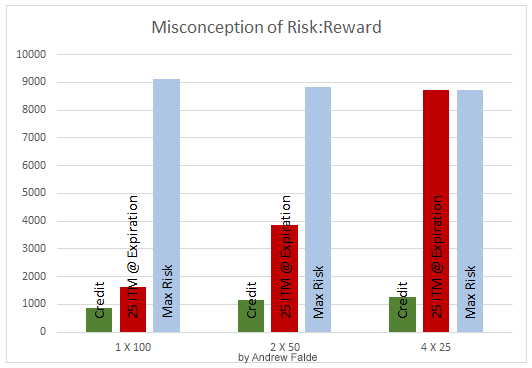When analyzing a vertical based credit spread, including iron condors and butterflies, the first question that usually comes up is where to place the short strike. In a distant second usually comes the question of where to place the long strike, that is how wide the spread will be. This leaves some analysis to be done on using more contracts for narrow spreads or fewer contracts for wide spreads.
At first glance it seems to be a better deal to narrow your spread and double the number of contracts. This is a major misconception I had about credit spreads when I started trading and later discovered the real trade off which I will now briefly explain.
When focusing on the credit only, yes, the narrower spread looks better. However, you have to look closely at where your risk is. A small move past your short strike can generate many multiples of loss compared to the small additional credit that you original saw from narrowing your spread.
Here are some examples using three different spreads. The first is a single Put spread 100 strikes wide. The second is two contracts and 50 strikes wide. The third is four contracts and 25 strikes wide. All of these spreads use $10K margin. But let’s break down the risk:reward.
In green you see the credit. In blue, the maximum loss if the spread is 100% in the money (ITM) at expiration. I’ve also included the very real fact that there is something between 100% OTM and 100% ITM at expiration. This is represented by the red bar which is 25 strikes ITM at expiration.
The green and blue bars are the data points that most options traders typically focus on when making a risk:reward trade decision. The credit to total risk ratio seems better in the 4 x 25 spread, but when you include the slightly ITM expiration loss (the red bar) there is no comparison.
So what is going on here?
This is a matter of market EXPOSURE. When you short four SPX Put contracts at a level (let’s use 1725 for example); then you are taking on the exposure of $690,000 ($1,725 x 4 x 100) of investment into the SPX at that level. If the market expires 25 points lower after you take on that obligation; then you have a loss of $25 per 400 units. If you take the same scenario and only short one Put contract, then your exposure is only $172,500 ($1,725 x 1 x 100), which is impacted far less per point.
Here is a quick chart of the same data shown in the picture
| 1 X 100 | 2 X 50 | 4 X 25 | |
| Credit | 865 | 1,150 | 1,280 |
| 25 ITM | 1,635 | 3,850 | 8,720 |
| Max | 9,135 | 8,850 | 8,720 |
At 25 strikes ITM; the narrow 4 X 25 spread looses $8,720 at expiration, the wide 1 X 100 spread only looses $1,635 (that’s over 500% greater loss!). The credits received on these are $1,280 and $865 respectively (47% different). A few hundred dollars of credit for several thousand dollars of increased exposure on a slightly ITM expiration is not a good trade off in my book.
None of this takes into account the increased commissions and possible spread risk from selling multiple contracts. If you are trading equities or ETFs such as SPY and IWM, then these other factors make an enormous impact on your net results.
At first it seems that narrow spreads offer lower risk than wider spreads. Like many things in the market, this is entirely backward. I encourage you to make sure that you fully understand the exposure that your short contracts represent. This can be a sobering fact for newer traders that think their spread risk represents their market exposure.
I look forward to hearing your thoughts and questions on this topic.
Andrew Falde
Risk Disclosure
No relevant positions



One Comment on “The Case for Wider Option Spreads”
I see your point if the trade is allowed to go ITM. What if the trade is exited well before that point?
I’m trying out very high probability short puts on SPY with wide spreads as a kind of safety net if I fail to execute my manual stop-loss exit. Entering at 90% prob OTM about 50 days out and stop-loss exit at 70% prob OTM.
I can deploy more capital through narrow spreads and multiple contracts because my broker sets less in reserve than if I used wider spreads. But of course then I’m buying pricier “insurance” that I’ll hardly ever use at these probability levels. Any thoughts?